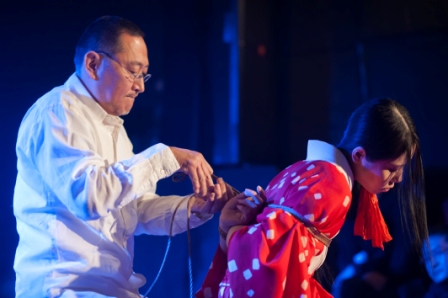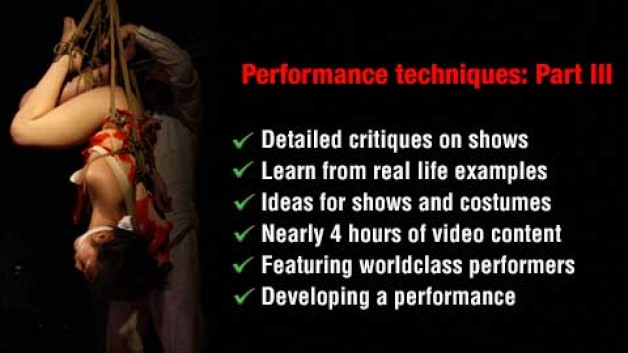We have just completed and uploaded shibari ‘Performance Techniques: Part III’. In this third part of the series, we will look at what makes a shibari performance and explore the various types of kinbaku shows. Having been on the western shibari scene since its earliest days, I have not only seen many hundreds of shows of every conceivable type but also witnessed the development of shibari as a performance art. Thus, Nina and I have a wealth of experience to pass on to you both as observers and as performers.
The London Festival of the Art of Japanese Rope Bondage, which I ran for 5 years with Garry Vanderhorne (now organiser of Lucha Britannia) and Nawashi Murakawa, was pivotal in developing both the art of shibari and as a catalyst for high level shows in Europe and beyond. In addition, visiting festivals around the world, trips to Japan and our regular BOUND event exposed us to countless performances by riggers of all levels, including many of Japan’s most revered bakushi, and provided numerous opportunities to perform. As a result, we can draw from an almost unparalleled experience to help you perform to the best of your ability.
Developing your creativity
In this course, we will look beyond the obvious to help you think outside the box when deciding upon what sort of show to do to capture your audience. The secret is the right show for the right audience. More often than not, it is this and what you add beyond your rope skills that is important. A creative novice who hits the spot can get a better reaction than a far more skilled rigger who misses it. Likewise, I have seen some of the best being almost ignored because they didn’t grab the public’s attention.

Old-school to ‘circus bondage’
We have included everything from the very traditional old-school style formats that create a series of tableaux to dynamic ‘circus bondage’, humour, examples of drawing from one’s own culture, audience participation and some of the more adventurous modern takes. As learning by example is one of the best methods, we have analysed and critiqued the good, the bad and the ugly so you can see what was done well and what could have been better.
The tutorial contains nearly four hours of video tutorials, critiques and performances from which you will gain invaluable insights into how to develop yourself as the best performer you can be.


